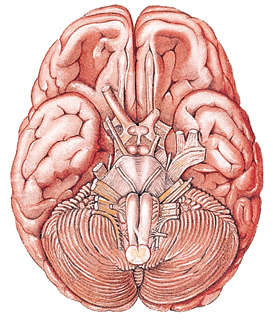Brain tumors are abnormal growths that form in the brain tissue itself or in the membranes surrounding the brain and spinal cord. These tumors can be benign or malignant tumors that have transferred from other sites in the body (known as metastatic tumors). Both primary (a tumor that originated in the brain) and metastatic brain tumors can compress sensitive brain tissue and nerves within the head, causing patients to experience symptoms such as vision loss, hearing loss, difficulties with balance, pain or seizures. As these tumors grow larger, they can be life-threatening because they disrupt critical parts of the brain that are responsible for breathing and other basic life functions.
 The CyberKnife System offers patients a noninvasive alternative to brain surgery when they are faced with this disease. Our physicians can use the CyberKnife System to treat brain tumors that may otherwise be considered inoperable because of their location in the head. CyberKnife can also be used to treat patients who cannot undergo brain cancer surgery due to their poor medical condition or those who do not want to undergo surgery.
The CyberKnife System offers patients a noninvasive alternative to brain surgery when they are faced with this disease. Our physicians can use the CyberKnife System to treat brain tumors that may otherwise be considered inoperable because of their location in the head. CyberKnife can also be used to treat patients who cannot undergo brain cancer surgery due to their poor medical condition or those who do not want to undergo surgery.
Initially, the use of CyberKnife was primarily in the brain and brainstem. This was due to early development in the 1980s of stereotactic radiosurgery, which involved the use of a large piece of equipment that was attached to the skull. More recent modern stereotactic radiosurgery involves the use of a frameless (not attached to the skull) free-moving robot that delivers radiation to a tumor located within the brain or elsewhere in the head. This non-surgical procedure delivers a single high dose of precisely-targeted radiation using highly focused gamma ray or X-ray beams that converge on the specific area or areas of the brain where the tumor or other abnormality resides, minimizing the amount of radiation to healthy brain tissue.
CyberKnife has been used to treat several types of primary brain tumors, including:
- Meningiomas,
- Pituitary adenomas,
- Schwannomas, and
- Gliomas.
The CyberKnife System can also treat metastatic brain tumors that result from invasive tumors (malignant tumors that grow into surrounding tissue) originating from other parts of the body through the bloodstream, along nerves or within the fluid surrounding the spinal cord and brain. These cells most commonly originate in tumors within the lung, breast, skin or colon, and are deposited in the brain where they grow into a tumor. Additionally other noncancerous tumors and other conditions, such as trigeminal neuralgia (affecting the nerves going to the face) and arterial venous malformations (AVMs) can be treated successfully using CyberKnife.
For most patients, CyberKnife brain cancer treatments are typically performed on an outpatient basis over a period of one to five days, requiring no overnight hospital stays. With this procedure, most patients experience minimal to no side effects during and after treatment. Most patients usually experience a quick recovery time following the procedure.